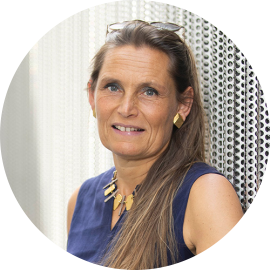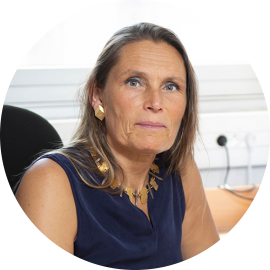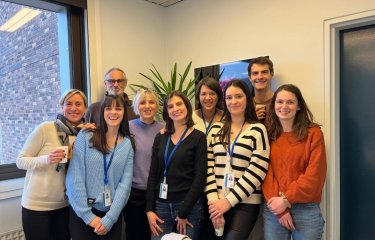It's a day of strikes in Paris and the French capital is virtually paralyzed, but it will take more than that to stop Sandrine Etienne-Manneville from arriving on time to explain her scientific research.
She's an old hand at this kind of thing and is enthusiastic as she presents the research she leads with her team in the Cell Polarity, Migration and Cancer Unit.
Learning from others and teaching others
At middle school, Sandrine was already eager to learn. She raced through her biology textbooks before the teacher had even started the first chapter. These books opened up a treasure trove of knowledge about the living world and answered the many questions she had.
Today, after a PhD at the Institut Cochin, a postdoctoral fellowship in London and a research position at the Institut Curie, Sandrine leads her own team at the Institut Pasteur (since 2006), which focuses on the migration and invasion of normal and tumor cells.
"When you work on a research topic, you are so specialized in a field that only around a hundred scientists worldwide can fully understand our scientific articles. It would be easy to lose sight of the wider meaning and impact of our research. Sharing our knowledge with as many people as possible makes me place it in a broader context and stops me from losing sight of the fact that the main reason we do what we do is to improve our understanding and treatment of disease.
I taught biology for 12 years at the Ecole Polytechnique, and I now try to teach people of all ages and levels as a guest speaker, from primary schools right up to doctoral schools and preparatory courses for the "agrégation," France's high-level teaching qualification. I find it so important and also really gratifying to return to basic knowledge in biology and share that knowledge with both students and the general public. Their questions make us want to take our work that one step further!"
Leading an international team working on brain cancer
In Sandrine's Institut Pasteur team, 12 scientists, technicians, postdoctoral fellows and PhD students work to elucidate the mechanisms responsible for the invasive properties of glioblastoma cells, which make this type of brain tumor particularly aggressive and incurable.
Although glioblastomas are relatively rare compared with other forms of cancer in adults, they represent the second leading type of childhood cancer in France and the leading cause of cancer mortality in children.

" Leading a research team gives me the opportunity to explore several avenues of research at the same time. The advantage is that the results and observations of each member of the team complement each other and further advance our understanding of the mechanisms involved in tumor invasion.
The make-up of my team is extremely diverse in terms of age, culture and interests. This multiplicity of viewpoints can be seen in both the interpretation of their results and their approach to designing research projects."
The brain, a singular organDuring her studies and her discovery of the various aspects of biology, Sandrine Etienne-Manneville was particularly intrigued by the notion of communication between cells, tissues and organs. The focus of her interest was research into integrated systems like the immune system and the nervous system, and the links between those different systems. The brain is an organ that is somewhat separate and typically does not regenerate. It is relatively isolated from the rest of the body by the blood-brain barrier and the meninges. This means that its interactions with the immune system and its defense mechanisms against disease are highly distinctive. The brain is made up of specific cells: neurons, of course, but also glial cells, which manage several tasks that contribute to the proper operation and protection of neurons. Among the different types of glial cell, astrocytes – literally "star-shaped cells" – are particularly crucial. They supply neurons with fuel and facilitate neuron-to-neuron communication. They also generate the glial scar, which can isolate brain regions where lesions have formed after a trauma such as a stroke or following surgery. |
When cells get carried away
Sandrine's PhD looked at the entry mechanisms of immune cells into the brain and the role played by astrocytes in closely controlling this process.
She then turned her attention to astrocytes in particular. When astrocytes become cancerous and start to multiply in the brain, they spread in a highly invasive and diffuse way. Sandrine's laboratory therefore focused its research on the migration mechanisms employed by healthy astrocytes, and more recently also those of glioblastoma cells, which are derived from glial cells. Together with her team, she is attempting to answer the following questions: how does a tumor cell acquire invasive properties? How can we slow down, speed up or stop the migration of healthy and tumor cells?
"In practice, hospitals send us purified samples of cells from patients with glioblastomas. In the lab, we try to understand how these cells migrate and we also try to look for targets that could curb them. We also work on little fish known as zebrafish. The advantage of using zebrafish as a model is the transparency of their tissues, which enable us to observe and film the movement of living cells, in vivo, within brain tissue."

By identifying the molecular characteristics that differentiate non-invasive cells from highly invasive cells, we will be able to identify the most invasive cells in patients, leading to improvements in diagnostics and therefore therapeutic strategies in both adults and children.
Video caption: Glioblastoma cells express a fluorescent protein that visualizes the dynamics of microtubules (cell filaments necessary for glioblastoma cell invasion) as the cells invade zebrafish larval brain tissue. Fish blood vessel cells are visible in green.
Key dates in Sandrine Etienne-Manneville's career
1991-1995: Ecole Normale Supérieure, Paris, France
1998: PhD in Immunology, Institut Cochin, Paris, France
1999-2003: Postdoctoral fellowship, MRC Laboratory for Molecular Cell Biology, London, United Kingdom
2003: Appointed as a research associate (CNRS CR2) at the Institut Curie, Paris, France
2006: Appointed as team leader at the Institut Pasteur, Paris, France
Distinctions
-
Appointed as a member of EMBO, 2015
-
Appointed as a Chevalier of the National Order of Merit, 2015
-
Pasteur Vallery-Radot Prize, 2015
-
EMBO Young Investigator, 2007
-
CNRS Bronze Medal, 2006
-
ATIP CNRS-G5 Institut Pasteur, 2006






